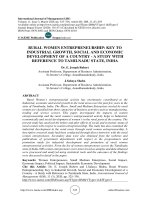Economic growth and economic development 153
Bạn đang xem bản rút gọn của tài liệu. Xem và tải ngay bản đầy đủ của tài liệu tại đây (127.05 KB, 1 trang )
Introduction to Modern Economic Growth
was not entirely misleading in emphasizing the importance of physical and
human capital.
(2) However, differently from the regression analysis, this exercise also shows
that there are significant technology (productivity) differences. There are
often large gaps between predicted and actual incomes, showing the importance of technology differences across countries. This can be most easily
seen in the first three figures, where practically all observations are above
the 45◦ , which implies that the neoclassical model is over predicting the
income level of countries that are poorer than the United States.
(3) The same pattern is visible in the next three figures, which plot, the estimates of the technology differences, Aj /AUS , against log GDP per capita
in the corresponding year. These differences are often substantial. More
important, these differences are also strongly correlated with income per
capita; richer countries appear to have “better technologies”.
(4) Also interesting is the pattern that the empirical fit of the neoclassical
growth model seems to deteriorate over time. In the first three figures, the
observations are further above the 45◦ in the later years, and in the last
three figures, the relative technology differences become larger. Why the
fit of the simple neoclassical growth model is better in 1980 than in 2000 is
an interesting and largely unanswered question.
3.5.2. Challenges. In the same way as the regression analysis was based on a
number of stringent assumptions (in particular, the assumption that technology differences across countries were orthogonal to other factors), the calibration approach
also relies on certain important assumptions. The above exposition highlighted several of those. In addition to the standard assumptions of competitive factor markets,
we had to assume no human capital externalities, a Cobb-Douglas production function, and also make a range of approximations to measure cross-country differences
in the stocks of physical and human capital.
Here let us focus on the functional form assumptions. Could we get away without
the Cobb-Douglas production function? The answer is yes, but not perfectly. The
reason for this is the same as the reason why the over-time TFP accounting approach
139









